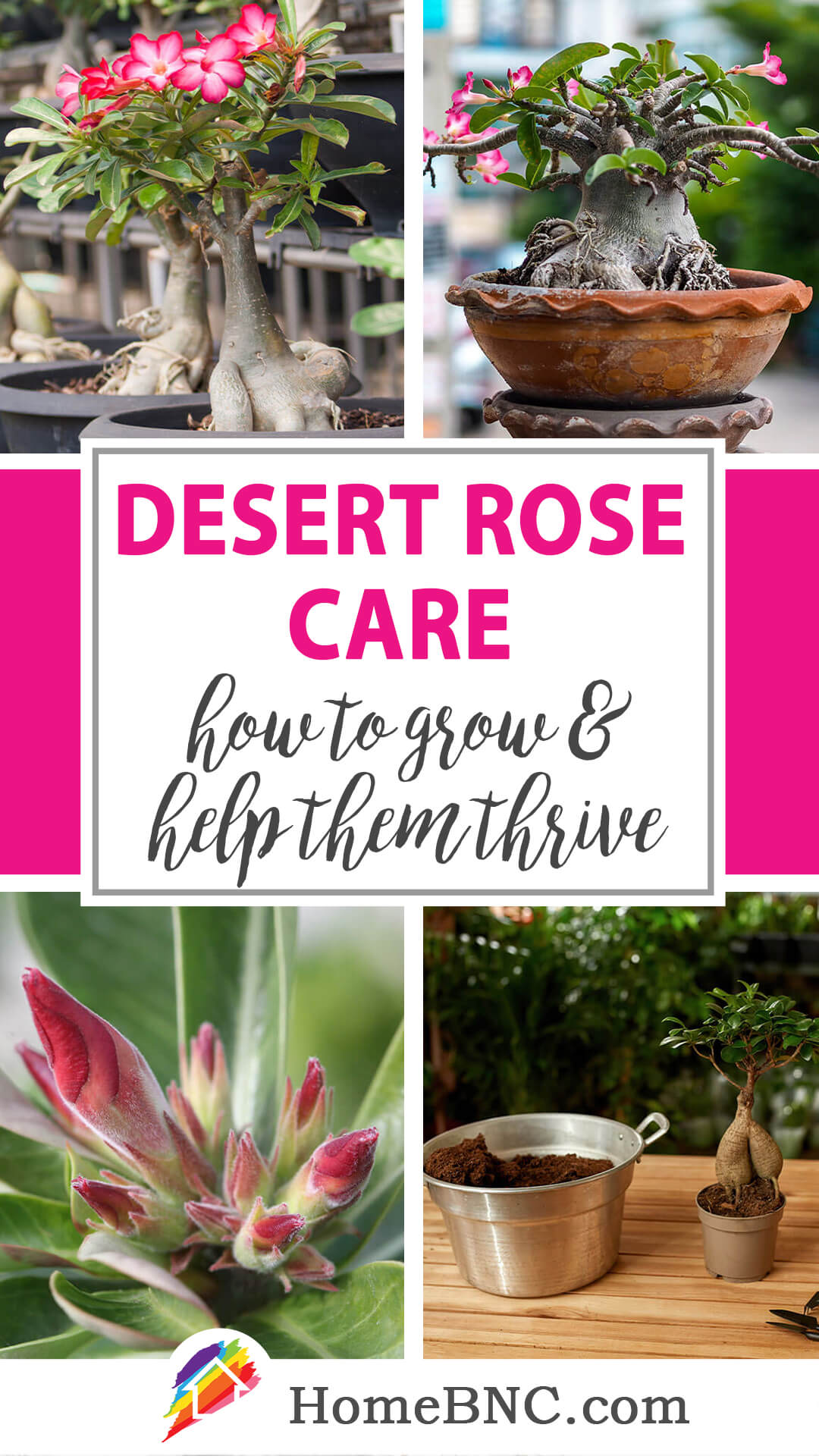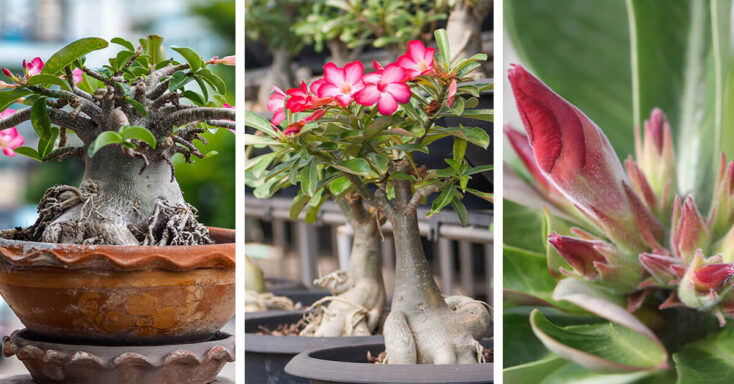You may not have heard about the desert rose (Adenium obesum), but you can find it in many garden centers. The 2-3 inch, pinkish-red flowers top a tree-like shape. It’s charming, with green-gray stems and green, trifoliate leaves sometimes variegated for more variety. And, you can learn how to care for an indoor desert rose as part of your household garden.
The Desert Rose Darling
Desert roses are lovely succulents. They produce trumpet-shaped flowers as if to announce themselves. You can find them in white, rose, or pink, blossoming in the summer. It’s a low-maintenance plant, which makes it ideal for your indoor garden, as well as for beginners who want a plant with which they can succeed.
At first glance, you may think you’re seeing a bonsai tree. The tree trunk certainly alludes to that. However, the desert rose isn’t as difficult to care for as a bonsai. One note about success, however: if your plant does not get enough sun, it will not blossom.
Hybrids of the Desert Rose have single, double, and even triple blossoms (talk about overachievers). Like most succulents, there are three necessities for their health: light, heat, and dryness.
Key Takeaways
- The desert rose is actually succulent. As a result, it has similar lighting and watering needs.
- Your desert rose won’t blossom if it doesn’t receive enough light.
- You can start growing desert roses from seed.
- If you’re a beginner gardener, desert rose is one potential choice for your indoor efforts, provided you learn about care necessities.
9 Desert Rose Growing Observations & Insights
Desert Roses are from Venus: Well, not exactly. In astrology, the desert rose has an association with the planet Venus. This planet symbolizes harmony, romance, and all the vibrations of love. People born under the sign of Taurus can find comfort and stability in the desert rose.
Types of Desert Rose
Desert rose finds itself in good company among plants with hybrids. Cross-pollination added new colors like purple to the variety.
- Adenium ababricum: This is a showy desert rose. It’s squat and may blossom with more than one color on the same plant.
- Adenium boehmianum: A desert rose variety with a purple-gray trunk. Pink and crimson flowers. The sap is toxic, so if you have pets, avoid this choice. Wear gloves when tending.
- Adenium multiforum: This hybrid has the traditional five-petaled flower, but the blossoms may be bi-colored.
- Adenium socotranum: If you’ve ever seen a baobab tree, this desert rose could visually be a kissin’ cousin. It is more tree-like than other varieties. The long, dark-green leaves set off the flowers beautifully.
- Adenium Somalense: Small white and pink flowers and fleshy green leaves. Excellent flower producer. Average height 4 feet.
- Adenium swazicum: The word swazicum means “tail of the impala” with good cause. The leaf clusters resemble the impala’s tail. This succulent grows long, velvet-green leaves, commonly with pink flowers.
The Egyptians used desert roses to remedy skin irritations. Native Americans also included it in their healer’s kit. Here, the flower represents compassion. Spiritually, the desert rose protects against negative psychic influences and wards against evil intent.
When to Plant Desert Rose
When starting from seed, sow in the spring. Make sure you have a well-drained pot at the ready. Soak the seeds for one hour beforehand. This rehydrates them. Put the seed 2 inches down into the soil and cover lightly. Only water when the soil dries. If kept in a warm location, sprouting should begin around 10 days.
Desert Rose Brings Wealth: In China, the desert rose bears the title “flower of wealth.” They believe it brings good fortune and fertility. You will see this plant (or its cultivars) prominently during the Lunar New Year, with wishes for wealth.
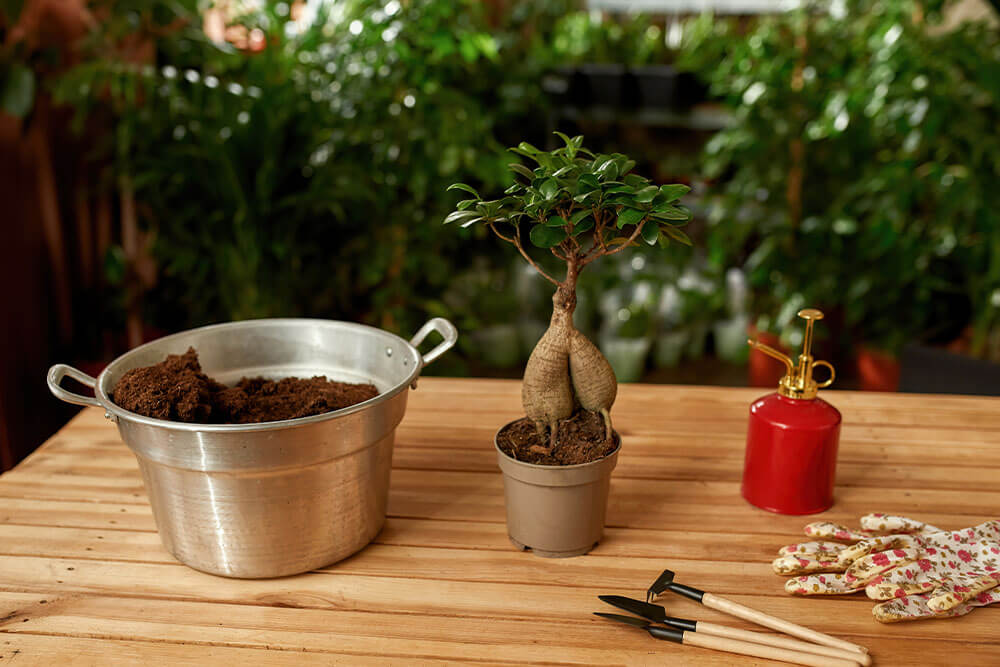
Desert Rose Growing Requirements
All plants need certain things: light, soil, water, the right temperature, and fertilizer. Of course, each plant is different. Let’s look at how to grow and care for your desert rose successfully.
- Fertilizer: Added nutrients help produce more flowers. Dilute a 6-30-30 liquid fertilizer by half and apply once a month.
- Lighting: Full sun. Use a southern-facing window, sunroom, or in an area with a ceiling light.
- Soil: As a succulent, you can use any soil produced specifically for these plants (think cactus soil). They like sand, gravel, and a slightly acidic pH (6.0).
- Temperature: The cactus rose does not like the cold one bit. If it sits in temperatures below 50 °F, it will die quickly. The best temperature range is °54-90 F.
- Water: The amount of moisture your plant needs depends a lot on temperature. The soil should remain moist, and it’s going to dry out faster when it’s hot. Just be careful to avoid over-watering. Desert roses are susceptible to root rot.
A trick master gardeners use is planting in terracotta or clay pots, which can wick away excess moisture. This is great for indoor gardening. However, if you ever plan to move the desert rose outdoors, these containers can crack from too much temperature change.
Not sure if your plant is getting enough water? If it has a thick, swollen trunk, your plant is growing just fine.
If you have a dream about the Desert Rose, you are on the threshold of healing and renewal. Positive changes are afoot, sprinkled with a little serendipity. It’s time for self-exploration and focusing on your purpose in place in the grand scheme. Trying something new may lead to success and abundance.
Pruning
No matter what plant you are pruning, always clean your tools first. Use a little rubbing alcohol to get rid of any lingering microorganisms that might harm the greenery, sneaking into the freshly pruned spot.
Prune your desert rose when you see damaged parts and lanky stems. Cut just above a leaf node. Continue pruning throughout the year to shape your plant and support root health. Watch for new growth, and prune before buds appear.
Home Sweet Home: Desert Roses originated in East Africa and Southern Arabia. They’re very popular as ornamental plants, especially in the West. Because people love its aesthetics, it’s traded globally, often for landscaping.
Repotting a Desert Rose
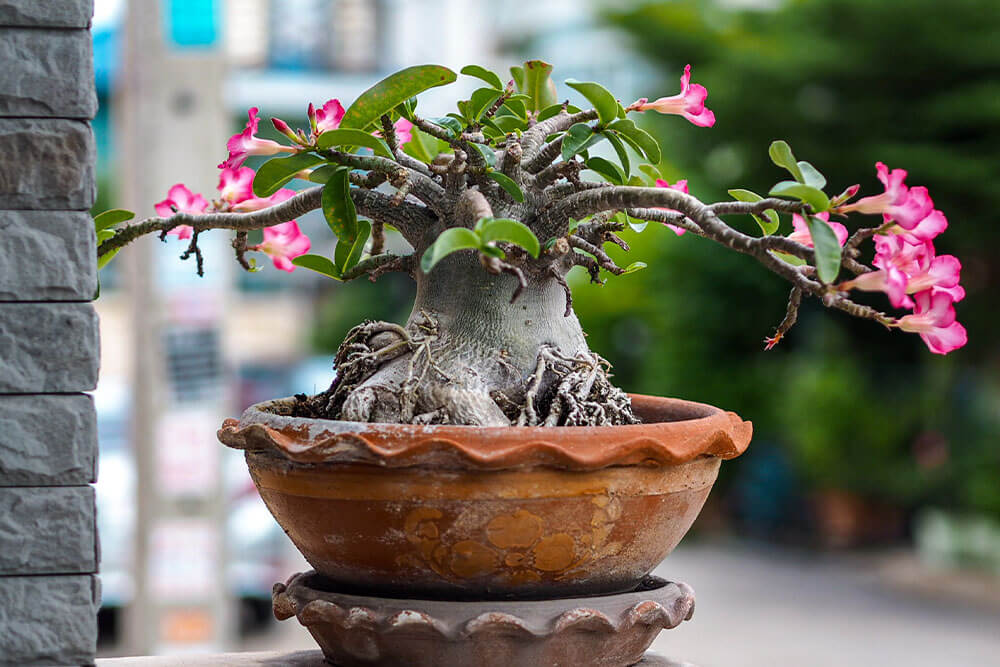
Your plant will tell you when it’s time for repotting. Just watch the roots. They’ll fill the container to overflowing. By repotting, you avoid the plant becoming root-bound. Based on your plant’s growth, you may need to repot every 18 months or so.
When you are ready to repot, wait for dry soil. Gently remove the plant from the original container. Knock away excess soil and trim any roots that appear rotting or dead. Put the desert rose into its new home filled with fresh soil. Spread the roots as you repot and backfill. Avoid watering the plant for about a week so you don’t shock the roots. Finally, water the succulent, watching to make sure the water drains properly.
It’s an Imposter: Despite its name, the desert rose is not a rose at all. It does not belong in the Rosaceae family, nor have thorns. Additionally, the flowers bear no resemblance to true roses.
Wintering Desert Roses
If there is any chance of prolonged cold in your area and your desert rose is outdoors, you need to protect these pants. Anything below 50 °F slows the plant into the dormant phase (it may appear dead, but it isn’t yet). In this phase, it uses very little sugar and water. The leaves of the desert rose drop. If there is any way to bring the plant somewhere warmer (like a garage), that’s your best bet for keeping your plant alive. While dormant, stop watering it.
When temperatures return that you trust to remain above 50 °F, return it outside and slowly begin providing water again.
Plants do not go dormant just because of the cold. Any time of stress, such as extreme environmental changes, can trigger the plant’s dormancy. Basically, the plant is trying to protect itself by using the least amount of resources for survival.
Desert Rose Pests and Diseases
There are a few signs that your desert rose isn’t feeling so well. Leaf Drop or yellowing leaves implies root rot or fungus. You will need to remove any damaged parts of the plant. Remove it from the container, and cut away any roots that appear mushy or blacked. Apply fungicide and replant in fresh soil.
Powdery mildew can also sneak in. The leaves look like they have blisters. A powdery residue appears on the leaves as well as the stems and buds. The easiest remedy is misting the leaves (the mildew does not like water). Also, apply a fungicide, and trim as necessary.
Pest-wise, spider mites suck the sap from the underside of desert flower leaves. The leaf will die. If you suspect spider mites, shake the plant over a white piece of paper. See those black dots? They’re the mites. Spider mites also leave webbing under the leaves. Take a sprayer and use it beneath the leaves. Do this every day for a week. Neem and insecticidal soap are also good options.
Petals of Positivity: Various cultures see the desert rose as the perfect emblem of hope when all seems lost. The plant is a vigorous survivor.
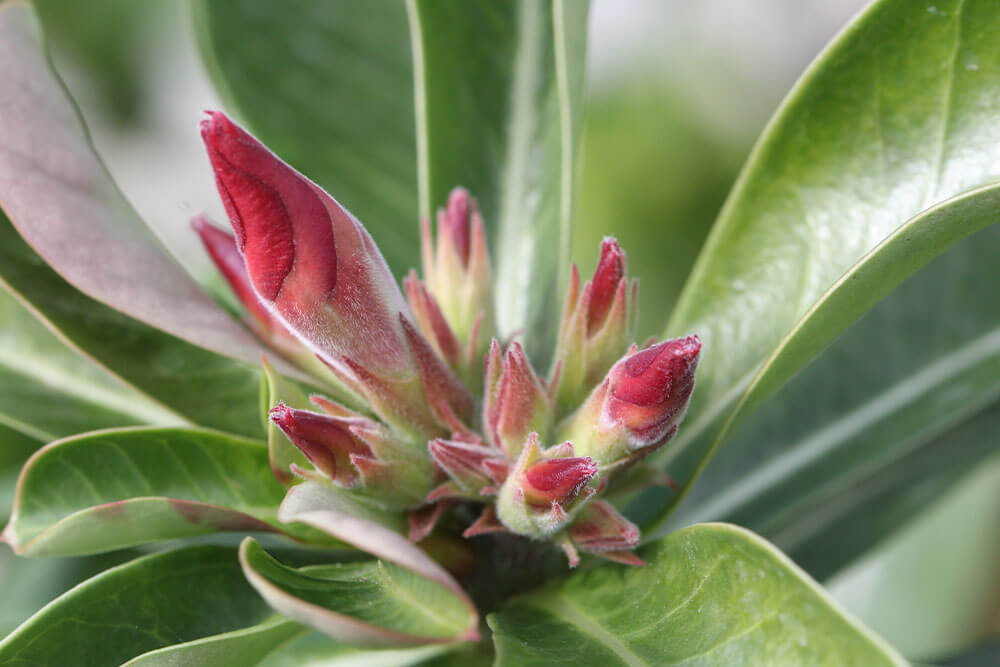
Common Desert Rose Problems
The desert rose has few diseases or pests to worry about. Your biggest enemy is over-watering. It’s a succulent, and while they don’t want it to be dry forever, make sure you water only when the top soil feels dry. Doing this actually deters diseases.
Keepin’ it Clean: In smudging rituals among some Native American homes, desert rose is part of the meditation process. It clarifies the mind and settles the spirit. Once focused, a person relays their intent to the desert rose, requesting positive energy.
Myth of the Desert Rose

There is an Arab legend about a flower with the most mesmerizing scent in the desert. Those who find it know that God was watching, offering strength even when they were exhausted and thirsty. It is also a sign of deep, abiding love.
A powerful and wealthy Arab sheikh married 12 women. They were each the most beautiful of their land. Each dedicated themselves to the just performance of their duties. The sheikh showed his appreciation to the wives on the 15th day of the month. He offers all manner of gifts, like rings and an exotic bath. In the women’s minds, this was what they deserved.
Sadly, the sheikh’s glory days were numbered. He became poor and lost everything he thought was valuable, including camels and gold. The only thing he had left was the love provided by his wives. He was almost immediately impressed at how they didn’t change their behavior toward him.
One day he gathered them and asked why they stayed. He said, “I have no more riches to give you.” Without words, each woman rose and kissed his face with love and respect. This action sparked wisdom in him and reminded the sheikh that “things” were worthless. Love was not.
The next day he departed on a pilgrimage without water or food. 15 days passed, leaving his wives distressed. As he entered their room, they were crying and praying for Allah to keep him safe.
In his hands, he bore a rose, one more beautiful than ever seen. He remarked that his intent was finding something cannot buy for them. It was the Desert Rose. The flower represents his abiding love for each of his wives.
He began giving each wife one petal from the rose. Finally, only the stem remained. From this story, the desert rose became a symbol of pure love.
The best measure of the age of a desert rose is the diameter of the plant. Each millimeter translates to approximately one year. Field studies begin with the circumference measurement to come up with an accurate diameter.
9 Explorations into the Desert Rose’s Basic Needs
The desert rose makes an interesting addition to your indoor garden-one sure to spur conversation. Your friends and family might think at first that you’ve taken up bonsai pruning. Their observation isn’t terribly off base. The stately curves of its trunk, topped with petals looking like feathers exploded, is a sight worth enjoying. If you enjoy the simplicity of growing succulents, you’re bound to fall in love with the desert rose. They’re little fuss plants, perfect for those with busy schedules. Open the door, and see the beauty awaiting you even when you didn’t have to do one thing for care over several days.
Frequently Asked Questions About Indoor Desert Rose Care
How much sun does a desert rose need?
Minimally, it requires 4-6 hours of direct sunlight daily. So you are going to need a southern pointing window or other space affording that much light. This placement helps keep them at a temperature over 60 F, which they prefer. They do need some protection from the high-noon sun to avoid leaf burn.
Does desert rose need big pots?
Not as big as you might expect. Start it in a 6-12 inch pot. It may live well there for a long time. If you see the roots creeping upward over the edge of the pot, it’s time for something bigger. Add a little clay to the new container’s soil to protect against water logging.
Should I mist my desert rose?
Yes, but you are not doing so for humidity. Rather, misting helps keep dust off your plant. Misting also keeps the soil slightly damp but not wet. Every couple of days should do the trick.
How often should you water desert roses?
Part of this answer is environmental. If it’s been hotter, you may need more water, and if it’s rainy, you may need none. The general rule is every three to four weeks with fertilization once a month. Just touch the top of the soil in the pot. Does it still feel damp? Wait a bit until it feels almost dry. And always check for proper drainage.
How do you keep a desert rose blooming?
A desert rose without sunshine will not bloom. The most vibrant displays come from plants that are slightly root bound. After about 3-4 years, replant it with fresh cactus or succulent soil. You can also deadhead your desert rose (deadheads often hide insects). It improves air circulation and opens the way for more sunlight into the entire plant.
What is the best type of soil for my desert rose?
You want a well-drained soil mixture like those created for cactus and other succulents. High-quality potting soil will work so long as it is slightly acidic (pH 6.0).
